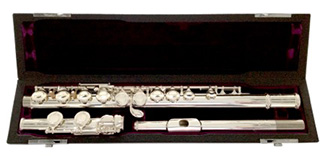The Flute

A musician who plays the flute can be referred to as a flute player, a flautist or a flutist.
Aside from the voice, flutes are one of the earliest known musical instruments.
Age or ability is no barrier to the enjoyment of your learning and if you happen to be a lapsed musician who played the instrument in earlier years, re-discovering or Rebooting of your flute playing can be a real joy!
Sound production
Back to basics! A flute player produces a musical note by creating a vibrating column of air inside their instrument. This is achieved by the player blowing across a hole in the headjoint in order for the air stream to be broken on the sharp edge of the lipplate. The flute player therefore directs the air stream across the embouchure hole of the headjoint in order to bounce it off the sharp edge on the far side and make it vibrate into the headjoint. The vibrations are in the pressure of the air and its corresponding motion, and are set up by the echoing or reflecting of sound inside the flute.
We are accustomed to thinking of the sound as echoing only off hard surfaces. With the flute however, the sound echoes off the openings in the tubes as well as off the tube walls. The characteristics of the echoes off the tube walls determine the tonal quality, while the characteristics of the echoes off the openings in the tube determines the pitch of the note produced.
A vibrating column of air is forced, whenever the sound is made, to echo between two openings in the flute. The length of the air column determines the frequency � and hence the pitch � of the note; the longer the column is, the lower the note is. The position of the ends of a column and therefore its length depends on which tone holes are open.
The lowest note a flute can produce corresponds to the longest column of air it can contain.
Your First Flute

With flute players especially, the production of the first note really determines the choice for the new or returning flute player. The flute is arguably the most natural of all instruments with the sound coming from the inside of the body in a way not possible with instruments that are hit or scraped. The flute is an extension of the players� speaking and singing voice. Their breath, muscles and fingers produce the sound without intervening technical complications. Nothing separates the player from the tone. No mechanism, reed, hammer, bow or string. In fact only singers have less paraphernalia between them and their listeners. Put in simple terms, you just put your lips to the flute and blow!
�O.K so what really makes a good first flute?�
A flute with an unresponsive headjoint is as useful as a family saloon trying to get up a hill, fully laden with passengers yet with only a 950cc engine � frustrating.
Well it really goes back to a new player visiting a music store for the first time. They are enthusiastic and want to play the instrument, therefore the ability and ease of sound production is of critical importance. The flute headjoint is therefore the single most important part of the flute.
Headjoint geometry appears particularly critical to acoustic performance and tone, but there is no clear consensus on a particular shape amongst manufacturers. Acoustic impedance of the embouchure hole appears the most critical parameter. Critical variables affecting this acoustic impedance include: chimney (riser) length (piece between lip-plate and head tube), chimney diameter, and radii or curvature of the ends of the chimney.
Returning to the new player visiting the music store for the first time, they therefore require a flute headjoint that is free blowing and open. Especially in the hard lower octave from F1 down to low C1 which is often difficult for the young player. The headjoint of the Trevor James 10x and Privilege flute is designed purely with the new or returning player in mind.